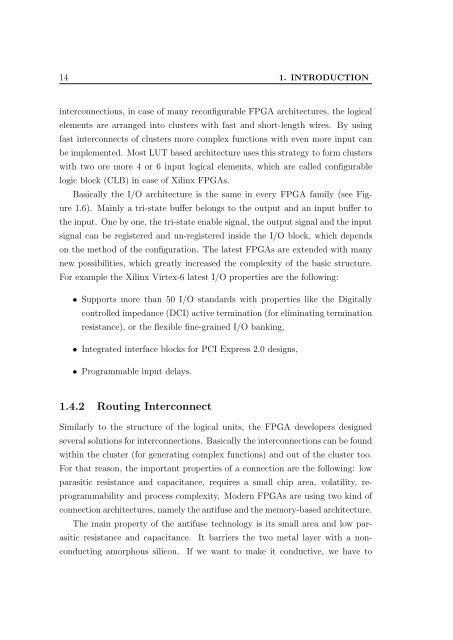PPKE ITK PhD and MPhil Thesis Classes
PPKE ITK PhD and MPhil Thesis Classes
PPKE ITK PhD and MPhil Thesis Classes
Create successful ePaper yourself
Turn your PDF publications into a flip-book with our unique Google optimized e-Paper software.
14 1. INTRODUCTION<br />
interconnections, in case of many reconfigurable FPGA architectures, the logical<br />
elements are arranged into clusters with fast <strong>and</strong> short-length wires. By using<br />
fast interconnects of clusters more complex functions with even more input can<br />
be implemented. Most LUT based architecture uses this strategy to form clusters<br />
with two ore more 4 or 6 input logical elements, which are called configurable<br />
logic block (CLB) in case of Xilinx FPGAs.<br />
Basically the I/O architecture is the same in every FPGA family (see Figure<br />
1.6). Mainly a tri-state buffer belongs to the output <strong>and</strong> an input buffer to<br />
the input. One by one, the tri-state enable signal, the output signal <strong>and</strong> the input<br />
signal can be registered <strong>and</strong> un-registered inside the I/O block, which depends<br />
on the method of the configuration. The latest FPGAs are extended with many<br />
new possibilities, which greatly increased the complexity of the basic structure.<br />
For example the Xilinx Virtex-6 latest I/O properties are the following:<br />
• Supports more than 50 I/O st<strong>and</strong>ards with properties like the Digitally<br />
controlled impedance (DCI) active termination (for eliminating termination<br />
resistance), or the flexible fine-grained I/O banking,<br />
• Integrated interface blocks for PCI Express 2.0 designs,<br />
• Programmable input delays.<br />
1.4.2 Routing Interconnect<br />
Similarly to the structure of the logical units, the FPGA developers designed<br />
several solutions for interconnections. Basically the interconnections can be found<br />
within the cluster (for generating complex functions) <strong>and</strong> out of the cluster too.<br />
For that reason, the important properties of a connection are the following: low<br />
parasitic resistance <strong>and</strong> capacitance, requires a small chip area, volatility, reprogrammability<br />
<strong>and</strong> process complexity. Modern FPGAs are using two kind of<br />
connection architectures, namely the antifuse <strong>and</strong> the memory-based architecture.<br />
The main property of the antifuse technology is its small area <strong>and</strong> low parasitic<br />
resistance <strong>and</strong> capacitance. It barriers the two metal layer with a nonconducting<br />
amorphous silicon. If we want to make it conductive, we have to






![optika tervezés [Kompatibilitási mód] - Ez itt...](https://img.yumpu.com/45881475/1/190x146/optika-tervezacs-kompatibilitasi-mad-ez-itt.jpg?quality=85)









